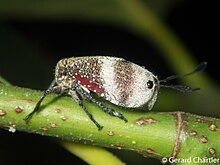
The family Fulgoridae is a large group of hemipteran insects, especially abundant and diverse in the tropics, containing over 125 genera worldwide. They are mostly of moderate to large size, many with a superficial resemblance to Lepidoptera due to their brilliant and varied coloration. Various genera and species are sometimes referred to as lanternflies or lanthorn flies, though they do not emit light.

A planthopper is any insect in the infraorder Fulgoromorpha: in the suborder Auchenorrhyncha and exceeding 12,500 described species worldwide. The name comes from their remarkable resemblance to leaves and other plants of their environment and from the fact that they often "hop" for quick transportation in a similar way to that of grasshoppers. However, planthoppers generally walk very slowly so as not to attract attention. Distributed worldwide, all members of this group are plant-feeders, though surprisingly few are considered pests. The infraorder contains only a single superfamily, Fulgoroidea. Fulgoroids are most reliably distinguished from the other Auchenorrhyncha by two features; the bifurcate ("Y"-shaped) anal vein in the forewing, and the thickened, three-segmented antennae, with a generally round or egg-shaped second segment (pedicel) that bears a fine filamentous arista.

Eurybrachidae is a small family of planthoppers with species occurring in parts of Asia, Australia and Africa. They are remarkable for the sophistication of their automimicry.

Pyrops is a genus of planthoppers that occur primarily in southeast Asia, containing about 70 species. They are fairly large insects, with much of the length due to an elongated, upcurving, snout-like projection of the head. The wings are generally brightly patterned in contrasting colors, and they are popular among collectors.

Derbidae is a family of insects in the order Hemiptera, the true bugs. It is one of the largest and most diverse families of planthoppers. It is widely distributed around the world, especially in the tropics, and with many species in subtropical and temperate regions.

The subfamily Aphaeninae is a group of hemipteran insects, especially abundant and diverse in the tropics. They belong to the Fulgoridae (fulgorids), though they are not among the more well-known members of that family which are called "lantern bugs" or "lanternflies". In 2009, the first molecular analysis of the Fulgoridae, challenged the existing structure of eight currently recognized subfamilies, and eleven tribes.

Flatidae are a family of fulgoroid planthoppers. They are cosmopolitan in distribution and are distinguished from others in the superfamily by a combination of characters. Like all other planthoppers, they suck phloem sap of plants. Some species are known to communicate with vibrations through the plant stems. Communication may be with mates, or with ants that tend the nymphs, protecting them and gathering honeydew secretions. Adults of some species have brightly coloured forewings which are tougher and known as tegmina unlike the membranous hindwings which are used for flight. Although a few can be identified by their coloration, most species requires dissection and examination under a microscope with access to literature on already described species.

Issidae is a family of planthoppers described by Spinola in 1839, belonging to the order Hemiptera, suborder Auchenorrhyncha superfamily Fulgoroidea.

Saiva gemmata is a species of lantern bug in the genus Saiva, found to the North-East of India and Indo-China. No subspecies are listed in the Catalogue of Life.

Penthicodes is a genus of bugs (Auchenorrhyncha) belonging to the family Fulgoridae, subfamily Aphaeninae: found in South-East Asia.

Bythopsyrna is a genus of planthoppers belonging to the family Flatidae.

Lycorma is a genus of insects in the family Fulgoridae: subfamily Aphaeninae; species are found in Asia. L. delicatula, known as the Spotted lanternfly, is an invasive species.
Saiva cardinalis is a species of lantern bug in the genus Saiva, found to the North-East of India, Nepal and Vietnam. No subspecies are listed in the Catalogue of Life.
Pyrgoteles is an unplaced genus of bugs in the family Fulgoridae: species can be found in Africa.

Penthicodes farinosa is a species of bugs in the sub family Aphaeninae (Fulgoridae): with five subspecies distributed in Indo-China and Malesia.

The Tettigometridae are a family of Fulgoromorpha (planthoppers), with a species distribution from: Europe, Africa, Asia through to west Malesia.
Datua is a monotypic genus of bugs containing the species Datua bisinuata and placed in the tribe Laternariini. The species is found in Borneo and Sumatra.
Hariola is a genus of bugs placed in the tribe Laternariini. The two known species are both found in New Guinea.

The Hemisphaeriinae are a subfamily of bugs in the family Issidae, based on the type genus Hemisphaerius. Species in 107 genera have been recorded in most continents, but the greatest diversity appears to be in South-East Asia.

Eurybrachys is a genus of bugs in the family Eurybrachidae. First formally named in 1834 by French entomologist Félix Édouard Guérin-Méneville, Eurybrachys is the type genus of the family Eurybrachidae. The spelling Eurybrachis, by the author, is considered an unaccepted orthographic variant. Species in this genus occur in Asia.













